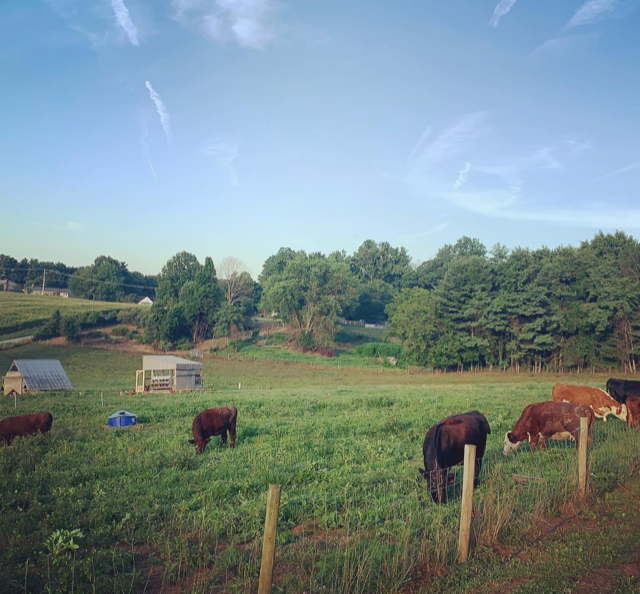What Is Regenerative Agriculture? And How We’re Working Toward It Every Day
posted on
August 3, 2025
If you’ve been hearing the phrase “regenerative agriculture” more often, you’re not alone. It’s one of the fastest-growing food movements in the country—and for good reason. But with all the buzzwords in food marketing these days, it can be hard to know what it actually means, how it’s different from “sustainable” or “organic,” and why it matters.
At Grand View Farm, we don’t claim perfection—this is a lifelong journey, not a destination. But we do believe in growing better food by working with nature instead of against it. That’s the heart of what regenerative agriculture is all about.
So let’s break it down.
What Is Regenerative Agriculture?
At its core, regenerative agriculture is a way of farming that seeks to restore and improve the health of the land over time—not just sustain it.
It’s focused on building soil health, improving biodiversity, and working in harmony with natural ecosystems so that farming actually makes the land better year after year. It’s not about extracting as much as we can from the land; it’s about giving back more than we take.
There’s no single definition or set of rules, but most regenerative farmers use practices like:
-
Rotational grazing to mimic natural herd movements
-
No or low synthetic chemical use
-
Cover cropping and diverse pasture mixes
-
Minimal soil disturbance (no tilling)
-
Focus on animal health and welfare
-
Transparency in how food is grown and raised
Why Are More People Talking About Regenerative Farming?
A national consumer trends report* released in 2024 found that:
-
65% of shoppers become extremely interested in regenerative products once they understand the farming behind them
-
96% of those consumers associate regenerative practices with better nutrition
-
89% say they’re willing to pay more for food raised in a regenerative way
That means consumers aren’t just looking for food that’s labeled “natural” or “organic.” They want food with a story—and with real impact behind it. Regenerative farming delivers both.
At Grand View Farm, we see that curiosity firsthand. Customers often ask us how we manage our land, how our animals are treated, and how we protect the environment. That tells us people are ready for something better—and that they want to support farms doing the hard work.
We'd love to share our story with you and as a customer we invite you to become part of our Farm Family.
How We’re Putting These Principles Into Practice
We don’t use the word “regenerative” lightly. While we’re not part of a certification program (and we’re cautious about greenwashing), we’ve quietly been working toward regenerative outcomes from the beginning.
Here are a few things we do every day that align with regenerative principles:
🐂 Rotational Grazing
We move our herds regularly from pasture to pasture, giving each section time to rest, regrow, and rebuild its root systems. This supports better grass growth, reduces parasite pressure, and naturally improves soil structure. Plus, we put multiple species on the pasture, which further promotes holistic cycles that are in sync with nature.
🌱 No Synthetic Inputs
We don’t spray chemicals on our pastures. Instead, we focus on soil biology—using the natural relationship between plants, animals, and microbes to build fertility over time.
🌾 Diverse Plant Life
We plant multi-species pasture blends that promote soil health and offer our animals a varied diet, which can lead to more nutrient-dense meat and better ecosystem resilience. The vitamins and minerals pass from the soil to you via the quality of the food you eat, so we put a heavy focus on the quality of our soils.
🐖 Animal Welfare at the Center
Healthy animals are part of a healthy farm, in fact our animals don't do drugs! We prioritize daily movement, low-stress handling, clean shelter, 24/7 access to forage, and 24/7 fresh air and sunlight.
👩🌾 Transparency You Can See
You don’t need a label or a stamp to know where your food comes from. Our customers can visit the farm, see the animals on pasture, and talk directly with the people doing the work. We think that matters just as much as any certification. In fact, we'd love to have you, your family and your friends out to the farm for one of our seasonal farm tours!
We’re Not Perfect—But We’re Committed
Regenerative agriculture isn’t a destination—it’s a mindset and a direction. We’re always learning, improving, and listening. The work of rebuilding soil, restoring ecosystems, and raising better food takes time and humility. But we believe it's worth it.
Whether you're already buying from farms like ours or just learning about regenerative farming for the first time, we’re glad you’re here.
We hope you’ll keep asking good questions, supporting small farms doing the work, and choosing food that makes a difference.
Ready to try regeneratively inspired meat?
Shop our regeneratively-raised meats now »
*Source: https://regenified.com/wp-cont...




